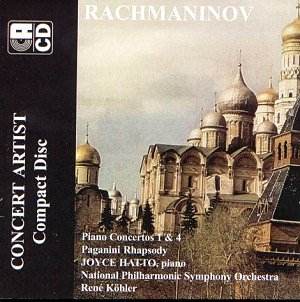AVAILABILITY
www.concertartistrecordings.com
We have already seen from her recording of the
Rachmaninov Third Concerto (reviewed
on this site) that Joyce Hatto possesses in abundance the
sweep and the grandeur and also the introspective depth that mark
out great romantic playing. In the First Concerto, Rachmaninovís
Op 1, she commands the rhetoric with absolute fluency and the
way in which she plays the second theme is a sure indication of
her deep sensitivity in this literature. She does so with splendid
cantabile phrasing of real beauty. Added to which her first movement
cadenza is of leonine persuasiveness and power and one is set
up for a performance of intense assurance. Her slow movement is
rightly reflective without undue lingering and the finale is relished
in authentically victorious style. Technical considerations are
swept asunder as Hatto confidently binds together the contrastive
rhetoric and drives to the magnificent conclusion. Someone like
Earl Wild, who incinerates this movement, taking it in 6.39 is
even faster by some distance than the composer himself in his
celebrated recording. Hatto maintains a strong directional pull
whilst not pulverising the finale.
And itís a similar story in the Fourth, if slightly
less exalted. Again the drive and the sweep are never at the service
of external considerations. Moments of reflection are woven into
the fabric of the performance and whilst there is bravura in abundance
one never feels it paraded for its own sake. In that strange Two
Lovely Black Eyes Largo we find Hatto exploring the poetic
implications with real understanding. Itís hardly to be wondered
by now that she succeeds in fusing the more declamatory outbursts
here with such a sense of rightness. In the finale the orchestra
is on strongly aggressive form (good first trumpet). Hatto still
finds moments of reflection and poetic insight and her filigree
treble virtuosity is really not in doubt.
In the Rhapsody on a Theme of Paganini her touch
is of great sensitivity. She occasionally retards the line (track
15) or emphasises the mordant grimness (track 17) but can also
be full of filigree grace (track 18). She phrases with almost
improvisatory individuality in the following variation and when
she plays Variation 18 (track 25) the expressivity is generated
by her rolled chords, by the incremental paragraph points, by
the sure sense of motion and movement and a tightening of the
syntax even at its most pressing and urgently romantic. I like
the way the rather swimmy orchestral counter-themes become clear
and come into sharp relief in track 29. This is a powerfully individual
performance - no carbon paper has ever come within a country mile
of her. Confident and expressive she meets this repertoire head
on.
Jonathan Woolf
MusicWeb
can offer the complete
Concert Artist catalogue
